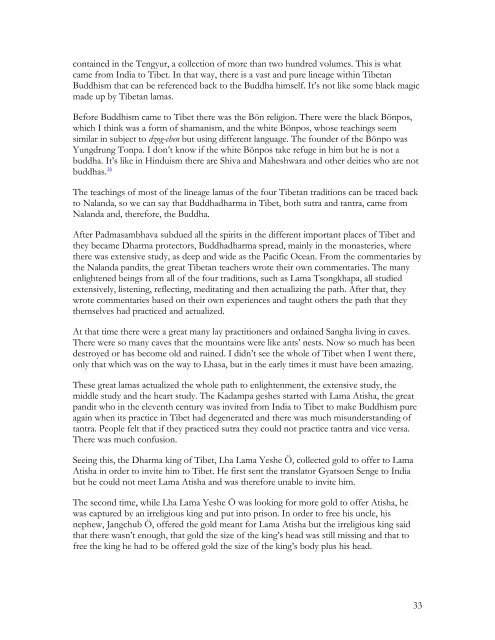Lama Zopa Rinpoche
55OTzl52A
55OTzl52A
You also want an ePaper? Increase the reach of your titles
YUMPU automatically turns print PDFs into web optimized ePapers that Google loves.
contained in the Tengyur, a collection of more than two hundred volumes. This is what<br />
came from India to Tibet. In that way, there is a vast and pure lineage within Tibetan<br />
Buddhism that can be referenced back to the Buddha himself. It’s not like some black magic<br />
made up by Tibetan lamas.<br />
Before Buddhism came to Tibet there was the Bön religion. There were the black Bönpos,<br />
which I think was a form of shamanism, and the white Bönpos, whose teachings seem<br />
similar in subject to dzog-chen but using different language. The founder of the Bönpo was<br />
Yungdrung Tonpa. I don’t know if the white Bönpos take refuge in him but he is not a<br />
buddha. It’s like in Hinduism there are Shiva and Maheshwara and other deities who are not<br />
buddhas. 16<br />
The teachings of most of the lineage lamas of the four Tibetan traditions can be traced back<br />
to Nalanda, so we can say that Buddhadharma in Tibet, both sutra and tantra, came from<br />
Nalanda and, therefore, the Buddha.<br />
After Padmasambhava subdued all the spirits in the different important places of Tibet and<br />
they became Dharma protectors, Buddhadharma spread, mainly in the monasteries, where<br />
there was extensive study, as deep and wide as the Pacific Ocean. From the commentaries by<br />
the Nalanda pandits, the great Tibetan teachers wrote their own commentaries. The many<br />
enlightened beings from all of the four traditions, such as <strong>Lama</strong> Tsongkhapa, all studied<br />
extensively, listening, reflecting, meditating and then actualizing the path. After that, they<br />
wrote commentaries based on their own experiences and taught others the path that they<br />
themselves had practiced and actualized.<br />
At that time there were a great many lay practitioners and ordained Sangha living in caves.<br />
There were so many caves that the mountains were like ants’ nests. Now so much has been<br />
destroyed or has become old and ruined. I didn’t see the whole of Tibet when I went there,<br />
only that which was on the way to Lhasa, but in the early times it must have been amazing.<br />
These great lamas actualized the whole path to enlightenment, the extensive study, the<br />
middle study and the heart study. The Kadampa geshes started with <strong>Lama</strong> Atisha, the great<br />
pandit who in the eleventh century was invited from India to Tibet to make Buddhism pure<br />
again when its practice in Tibet had degenerated and there was much misunderstanding of<br />
tantra. People felt that if they practiced sutra they could not practice tantra and vice versa.<br />
There was much confusion.<br />
Seeing this, the Dharma king of Tibet, Lha <strong>Lama</strong> Yeshe Ö, collected gold to offer to <strong>Lama</strong><br />
Atisha in order to invite him to Tibet. He first sent the translator Gyatsoen Senge to India<br />
but he could not meet <strong>Lama</strong> Atisha and was therefore unable to invite him.<br />
The second time, while Lha <strong>Lama</strong> Yeshe Ö was looking for more gold to offer Atisha, he<br />
was captured by an irreligious king and put into prison. In order to free his uncle, his<br />
nephew, Jangchub Ö, offered the gold meant for <strong>Lama</strong> Atisha but the irreligious king said<br />
that there wasn’t enough, that gold the size of the king’s head was still missing and that to<br />
free the king he had to be offered gold the size of the king’s body plus his head.<br />
33


